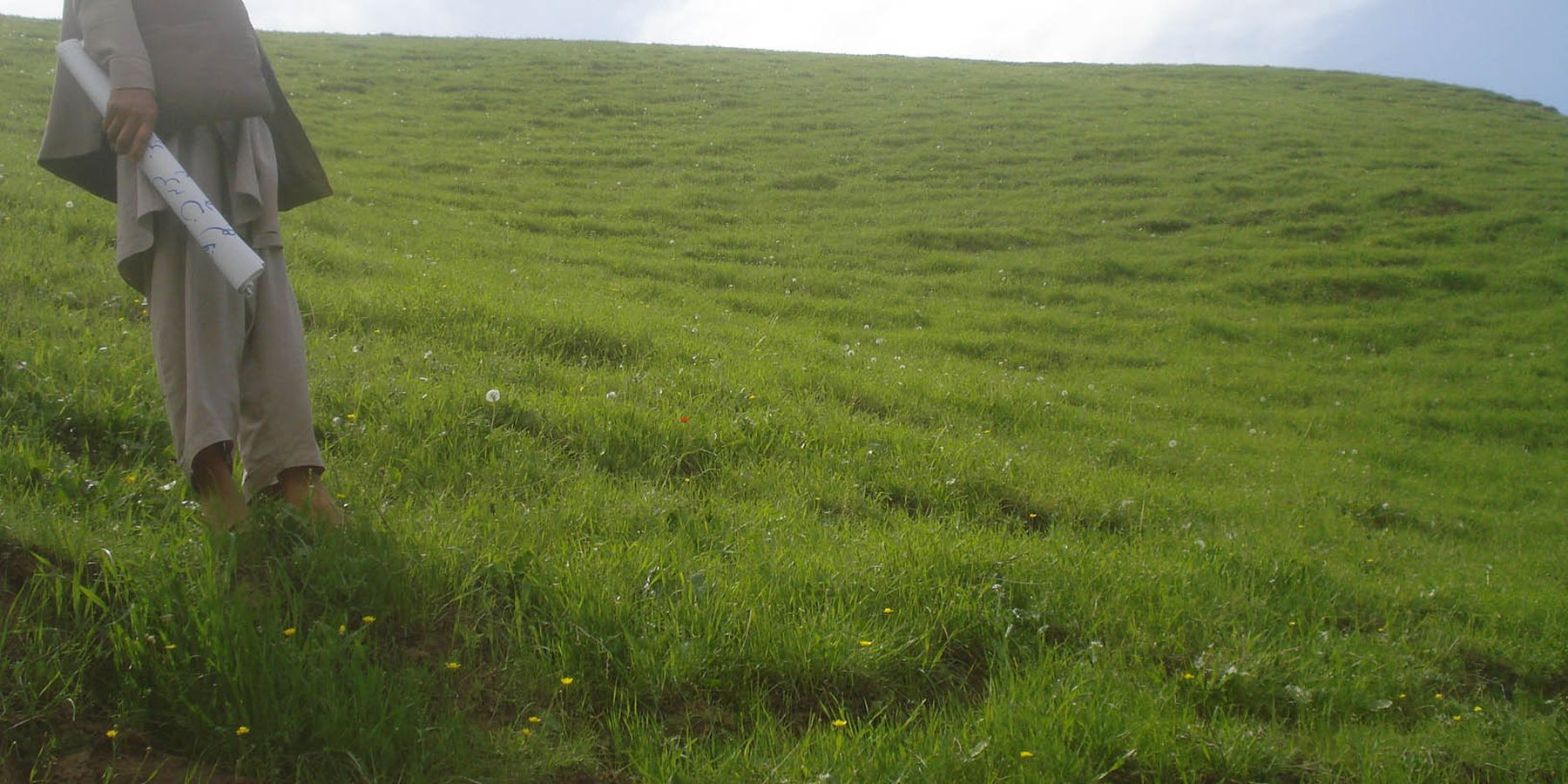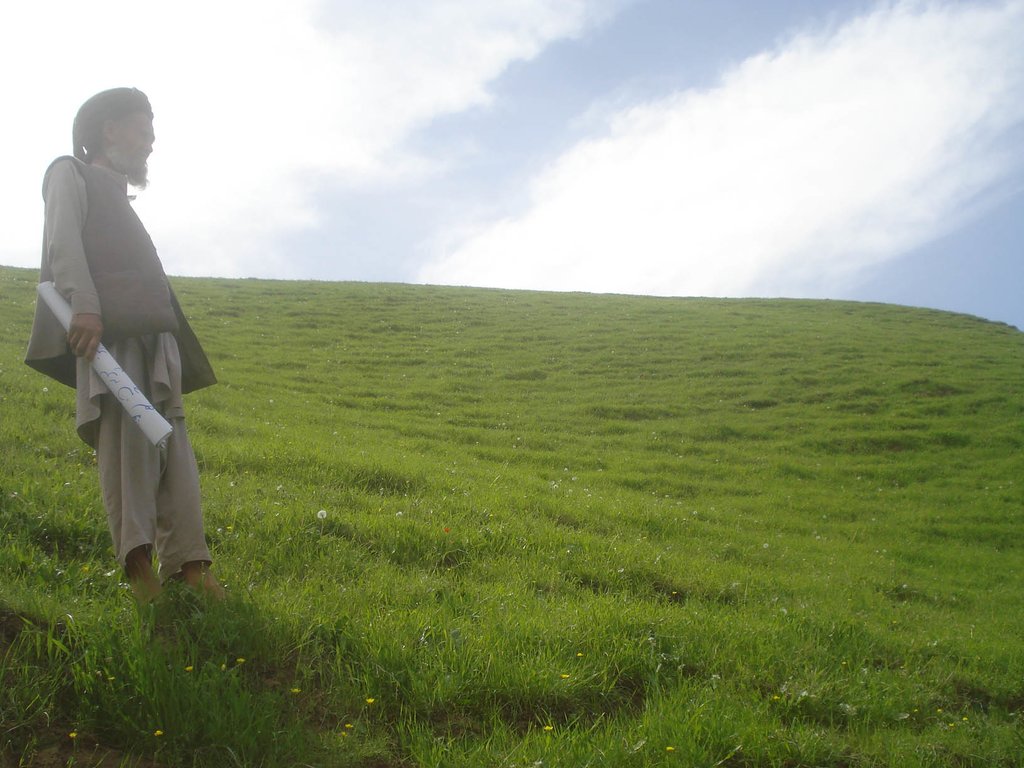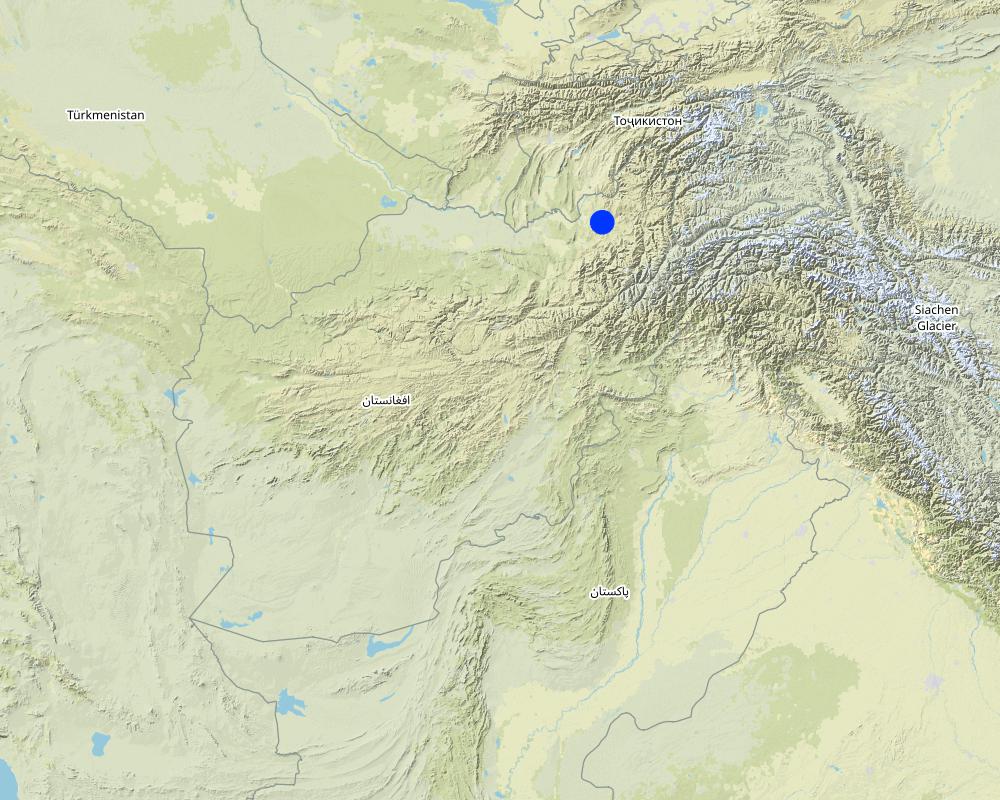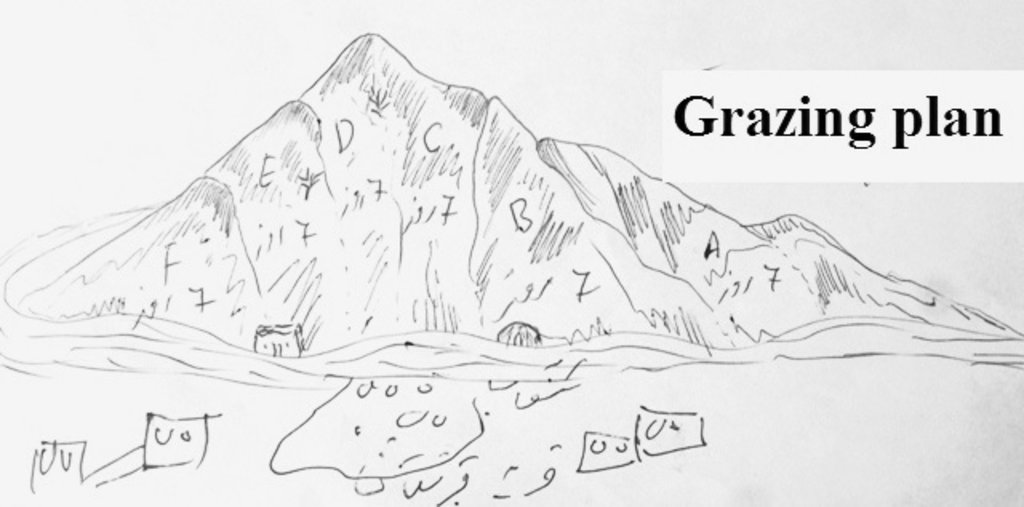Rotational grazing to restore degraded pastures [Afghanistan]
- Création :
- Mise à jour :
- Compilateur : Bettina Wolfgramm
- Rédacteurs : MIAJAN MAROOFI, Hekmatullah Sharifzai, Roziya Kirgizbekova, Aslam Qadamov
- Examinateur : William Critchley
Ploni ba navbat charonidani mol ba khotiri behbudi charogoh
technologies_671 - Afghanistan
Voir les sections
Développer tout Réduire tout1. Informations générales
1.2 Coordonnées des personnes-ressources et des institutions impliquées dans l'évaluation et la documentation de la Technologie
Spécialiste GDT:
Researcher:
Nom du projet qui a facilité la documentation/ l'évaluation de la Technologie (si pertinent)
Livelihood Improvement Project Takhar, Afghanistan (LIPT)Nom du projet qui a facilité la documentation/ l'évaluation de la Technologie (si pertinent)
Potential and limitations for improved natural resource management (NRM) in mountain communities in the Rustaq district, Afghanistan (Rustaq NRM Study)Nom du ou des institutions qui ont facilité la documentation/ l'évaluation de la Technologie (si pertinent)
Terre des Hommes (Terre des Hommes) - SuisseNom du ou des institutions qui ont facilité la documentation/ l'évaluation de la Technologie (si pertinent)
Swiss Agency for Development and Cooperation (DEZA / COSUDE / DDC / SDC) - SuisseNom du ou des institutions qui ont facilité la documentation/ l'évaluation de la Technologie (si pertinent)
CDE Centre for Development and Environment (CDE Centre for Development and Environment) - Suisse1.3 Conditions relatives à l'utilisation par WOCAT des données documentées
Quand les données ont-elles été compilées (sur le terrain)?
17/10/2016
Le compilateur et la(les) personne(s) ressource(s) acceptent les conditions relatives à l'utilisation par WOCAT des données documentées:
Oui
1.4 Déclaration sur la durabilité de la Technologie décrite
Est-ce que la Technologie décrite ici pose problème par rapport à la dégradation des terres, de telle sorte qu'elle ne peut pas être déclarée comme étant une technologie de gestion durable des terres?
Non
1.5 Référence au(x) questionnaire(s) sur les Approches de GDT
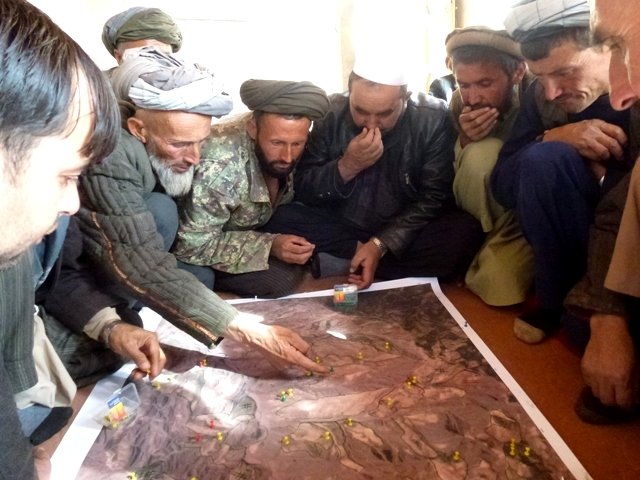
Watershed Associations (WSA) and Natural Resource Management Committees … [Afghanistan]
Two Watershed Associations (WSA), in Chaker and Nahristan watershed areas respectively, are registered at the national level with the Ministry of Agriculture Irrigation and Livestock (MAIL) and at the regional level with the Department of Agriculture. Both associations are strong, active, dynamic, and have the capacity to coordinate and support …
- Compilateur : Bettina Wolfgramm
2. Description de la Technologie de GDT
2.1 Courte description de la Technologie
Définition de la Technologie:
A plan for rotational grazing has been developed to control pasture use and prevent overgrazing of rehabilitated pastures.
2.2 Description détaillée de la Technologie
Description:
Livestock keeping is one of the key livelihood strategies in rural Rustaq, in addition to cultivation of cereals. Families rely on their livestock not only for consumption of meat from cattle, goats and sheep, and dairy products such as milk and sour milk, but also as means of transportation (donkeys), labour in agriculture (oxen, donkeys) and as a source of income through sales. Naturally, every family strives to increase their household’s livestock as much as they can, which increases the pressure on the local pastures - leading to extensive overgrazing. The pastures in Jawaz Khana and Sari Joy are characterized by poor vegetation cover, low carrying capacity and severe erosion with deep rills clearly visible. Heavy rains in spring and autumn wash off the topsoil on pastures, resulting in heavy erosion, landslides and gully formation. These severely degraded pastures continue to be used though "open access" - without any management schemes or regulations in place. Some pastures that are not suitable for grazing have been converted to arable lands and tree plantations. The quantity and quality of livestock fodder is insufficient for all the livestock, and this affects animal health.
Plans for rotational grazing were prepared for the communities in Sari Joy and Jawaz Khana to organize the use of local pastures and prevent their further degradation. Rotational grazing plans regulate the frequency and intensity of livestock grazing on the pastures. The area is seeded with alfalfa to improve the fodder stock and enhance the quality of the pasture. For up to three years the seeded area is closed to grazing, during which period the community is provided with stocks of hay and straw to feed their livestock as an alternative. After the end of the closure period, the grazing area is divided into 6-7 sections (paddocks) depending on the area of the pasture. The livestock graze the first paddock for 7 days and move to the next paddock. Each paddock is grazed for the period of 7 days during April and May. From the month of May the grazing area is closed for resting. The livestock move to the summer pastures for the rest of the summer months.
The community is key in preparing the grazing plans and identifying the pastures where these plans will be applied, as well as the conditions which are part of it, such as the frequency of the grazing period. Frequent meetings need to be held with the community livestock holders to explain the purpose of the rotational grazing and how it can be beneficial in pasture improvement. The Natural Resources Management Committee and the technical staff of the Livelihood Improvement Project (LIPT) are in charge of engaging the local pasture users to meet their needs and consider their views accordingly.
The actual implementation of the rotational grazing plans is difficult to assess for the time being. The grazing area is not fully restored and the fodder stock remains low. Many land users do not fully understand the concept behind the rotational grazing plans or their purpose. In an area where there is a severe shortage of livestock fodder and very limited grazing land, accepting and following these plans will require more time and additional support in terms of awareness-raising and support feeding of the livestock during the exclusion period. The villagers have some doubts about the costs and benefits of grazing and rotation. They have no full understanding of the benefits of the rotational grazing for their household and are likely to be not ready to adhere to such schemes.
Women are part of the livestock management system, and are in charge of feeding and taking care of the livestock. However, they are not aware about the plans for rotational grazing in their village and how are these plans are applied in practice.
2.3 Photos de la Technologie
2.5 Pays/ région/ lieux où la Technologie a été appliquée et qui sont couverts par cette évaluation
Pays:
Afghanistan
Région/ Etat/ Province:
Takhar Province, Rustaq District
Autres spécifications du lieu:
Sari Joy and Jawaz Khana Villages
Map
×2.6 Date de mise en œuvre de la Technologie
Indiquez l'année de mise en œuvre:
2015
Si l'année précise est inconnue, indiquez la date approximative: :
- il y a moins de 10 ans (récemment)
2.7 Introduction de la Technologie
Spécifiez comment la Technologie a été introduite: :
- par le biais de projets/ d'interventions extérieures
Commentaires (type de projet, etc.) :
Livelihood Improvement Project in Takhar (LIPT) implemented by Terre des hommes (Tdh) Switzerland
3. Classification de la Technologie de GDT
3.1 Principal(aux) objectif(s) de la Technologie
- améliorer la production
- réduire, prévenir, restaurer les terres dégradées
3.2 Type(s) actuel(s) d'utilisation des terres, là où la Technologie est appliquée

Pâturages
Pâturage extensif:
- Semi-nomadisme/ pastoralisme
Pâturage intensif/ production fourragère :
- Prairies améliorées
Principales espèces animales et principaux produits:
Cow, Sheep, Goat. Alfalfa
Si l'utilisation des terres a changé en raison de la mise en œuvre de la Technologie, indiquez l'utilisation des terres avant la mise en œuvre de la Technologie:
Some areas under the Technology are former croplands, which have been completely degraded and no longer suitable for crop cultivation.
3.3 Informations complémentaires sur l'utilisation des terres
Approvisionnement en eau des terres sur lesquelles est appliquée la Technologie:
- pluvial
Nombre de période de croissance par an: :
- 1
3.4 Groupe de GDT auquel appartient la Technologie
- pastoralisme et gestion des pâturages
3.5 Diffusion de la Technologie
Spécifiez la diffusion de la Technologie:
- répartie uniformément sur une zone
Si la Technologie est uniformément répartie sur une zone, indiquez la superficie couverte approximative:
- 0,1-1 km2
Commentaires:
6 ha
3.6 Mesures de GDT constituant la Technologie

modes de gestion
- M2: Changement du niveau de gestion / d'intensification
3.7 Principaux types de dégradation des terres traités par la Technologie

érosion hydrique des sols
- Wt: perte de la couche superficielle des sols (couche arable)/ érosion de surface

érosion éolienne des sols
- Et: perte de la couche superficielle des sols (couche arable)

dégradation physique des sols
- Pc: compaction

dégradation biologique
- Bc: réduction de la couverture végétale
- Bq: baisse de la quantité/ biomasse

autre
3.8 Prévention, réduction de la dégradation ou réhabilitation des terres dégradées
Spécifiez l'objectif de la Technologie au regard de la dégradation des terres:
- restaurer/ réhabiliter des terres sévèrement dégradées
4. Spécifications techniques, activités, intrants et coûts de mise en œuvre
4.1 Dessin technique de la Technologie
4.2 Spécification/ explications techniques du dessin technique
After the end of the exclusion period the grazing area is divided into 6-7 sections (paddocks) depending on the area of the pasture. The livestock graze the first paddock for 7 days and move to the next paddock after 7 days. Each paddock is grazed for the period of 7 days during April and May. From the month of May the grazing area is closed for resting. The livestock move to the summer pastures for the rest of the summer months.
4.3 Informations générales sur le calcul des intrants et des coûts
Spécifiez la manière dont les coûts et les intrants ont été calculés:
- par superficie de la Technologie
Indiquez la taille et l'unité de surface:
1 ha
Indiquez la monnaie utilisée pour le calcul des coûts:
- dollars US
Indiquer le taux de change du dollars en monnaie locale (si pertinent): 1 USD= :
67,0
Indiquez le coût salarial moyen de la main d'œuvre par jour:
5.2-5.3 USD
4.4 Activités de mise en place/ d'établissement
| Activité | Type de mesures | Calendrier | |
|---|---|---|---|
| 1. | Selection of the pasture area and awareness raising among people | Modes de gestion | Fall |
| 2. | Leveling of the land | Agronomique | Fall |
| 3. | Sowing alfalfa seed | Agronomique | Spring |
| 4. | Site under quarantine | Modes de gestion | Three years |
| 5. | Preparation of the grazing plan and community meetings | Modes de gestion | Fall |
| 6. | Protection of the site during quarantine | Modes de gestion | Three years |
4.5 Coûts et intrants nécessaires à la mise en place
| Spécifiez les intrants | Unité | Quantité | Coûts par unité | Coût total par intrant | % des coût supporté par les exploitants des terres | |
|---|---|---|---|---|---|---|
| Main d'œuvre | Leveling the land with a rake | person-day | 150,0 | 5,3 | 795,0 | 71,0 |
| Main d'œuvre | Sowing alfalfa | person-day | 5,0 | 5,3 | 26,5 | 71,0 |
| Main d'œuvre | Preparation of grazing plan | person-day | 2,0 | 9,0 | 18,0 | |
| Main d'œuvre | Protection of the site | year | 1,0 | 447,0 | 447,0 | 100,0 |
| Equipements | Shovel | piece | 1,0 | 3,8 | 3,8 | 100,0 |
| Equipements | Rope | Meter | 50,0 | 0,15 | 7,5 | 100,0 |
| Equipements | Rake | piece | 1,0 | 3,0 | 3,0 | 100,0 |
| Matériel végétal | Alfalfa seed | kg | 17,5 | 0,42 | 7,35 | |
| Engrais et biocides | DAP | kg | 125,0 | 0,9 | 112,5 | |
| Engrais et biocides | Urea | kg | 125,0 | 0,45 | 56,25 | |
| Coût total de mise en place de la Technologie | 1476,9 | |||||
Si le coût n'est pas pris en charge à 100% par l'exploitant des terres, indiquez qui a financé le coût restant:
Livelihood Improvement Project Takhar (LIPT) implemented by Terre des hommes (Tdh) Switzerland
4.6 Activités d'entretien/ récurrentes
| Activité | Type de mesures | Calendrier/ fréquence | |
|---|---|---|---|
| 1. | Community agrees to leave the pasture for resting/ exclusion | Modes de gestion | Three years |
| 2. | Rotational grazing | Autres mesures | Spring/week/grazing plot |
| 3. | Reseeding alfalfa | Végétale | After 5 years |
| 4. | Protection of the site | Modes de gestion | Three years |
4.7 Coûts et intrants nécessaires aux activités d'entretien/ récurrentes (par an)
| Spécifiez les intrants | Unité | Quantité | Coûts par unité | Coût total par intrant | % des coût supporté par les exploitants des terres | |
|---|---|---|---|---|---|---|
| Main d'œuvre | Reseeding alfalfa | person day | 5,0 | 5,3 | 26,5 | 100,0 |
| Main d'œuvre | Protection during exclusion | year | 2,0 | 447,0 | 894,0 | 100,0 |
| Matériel végétal | Alfalfa seed | kg | 17,5 | 0,42 | 7,35 | 100,0 |
| Coût total d'entretien de la Technologie | 927,85 | |||||
Commentaires:
Costs calculated for a Technology area of 1ha was only done for the purpose of the WOCAT documentation. In reality SLM plots are on average 0.4 ha or 2 jiribs. Costs were simply multiplied by 2.5. The actual costs for a 1ha plot might be slightly different.
4.8 Facteurs les plus importants affectant les coûts
Décrivez les facteurs les plus importants affectant les coûts :
Due to the remoteness of the villages where the technology has been implemented, all the inputs for establishment, such as agricultural equipment, plant material, fertilizers, etc., are purchased in Rustaq town. The expenses for traveling and delivering the inputs affect the establishment costs.
5. Environnement naturel et humain
5.1 Climat
Précipitations annuelles
- < 250 mm
- 251-500 mm
- 501-750 mm
- 751-1000 mm
- 1001-1500 mm
- 1501-2000 mm
- 2001-3000 mm
- 3001-4000 mm
- > 4000 mm
Spécifications/ commentaires sur les précipitations:
Average annual precipitation for the area was calculated with 580 mm, with minimum in dry years (2000 and 2001) of 270 mm and maximum in wet years (2009/2010) of 830 mm. The absolute maximum rainfall was calculated for 1986 with 1024 mm. The data series covers the period from 1979 to 2014.
Zone agro-climatique
- semi-aride
5.2 Topographie
Pentes moyennes:
- plat (0-2 %)
- faible (3-5%)
- modéré (6-10%)
- onduleux (11-15%)
- vallonné (16-30%)
- raide (31-60%)
- très raide (>60%)
Reliefs:
- plateaux/ plaines
- crêtes
- flancs/ pentes de montagne
- flancs/ pentes de colline
- piémonts/ glacis (bas de pente)
- fonds de vallée/bas-fonds
Zones altitudinales:
- 0-100 m
- 101-500 m
- 501-1000 m
- 1001-1500 m
- 1501-2000 m
- 2001-2500 m
- 2501-3000 m
- 3001-4000 m
- > 4000 m
5.3 Sols
Profondeur moyenne du sol:
- très superficiel (0-20 cm)
- superficiel (21-50 cm)
- modérément profond (51-80 cm)
- profond (81-120 cm)
- très profond (>120 cm)
Texture du sol (de la couche arable):
- moyen (limoneux)
Texture du sol (> 20 cm sous la surface):
- grossier/ léger (sablonneux)
- moyen (limoneux)
Matière organique de la couche arable:
- faible (<1%)
Si disponible, joignez une description complète du sol ou précisez les informations disponibles, par ex., type de sol, pH/ acidité du sol, capacité d'échange cationique, azote, salinité, etc.
Local land users differentiate between the following soil types where the technology is implemented:
- Red: shallow; texture medium, coarse; low organic matter
- Light: moderately deep; texture medium; medium, low organic matter
5.4 Disponibilité et qualité de l'eau
Profondeur estimée de l’eau dans le sol:
5-50 m
Disponibilité de l’eau de surface:
moyenne
Qualité de l’eau (non traitée):
eau potable
La salinité de l'eau est-elle un problème? :
Non
La zone est-elle inondée?
Oui
Régularité:
épisodiquement
Commentaires et précisions supplémentaires sur la qualité et la quantité d'eau:
Floods occur mainly during the rainy seasons in spring and autumn. Availability of surface water differs for the villages of Sari Joy and Jawaz Khana. Sari Joy has good surface water availability. Jawaz Khana has poor water availability as water has to be fetched from a stream lower down.
5.5 Biodiversité
Diversité des espèces:
- faible
Diversité des habitats:
- faible
5.6 Caractéristiques des exploitants des terres appliquant la Technologie
Sédentaire ou nomade:
- Semi-nomade
Orientation du système de production:
- subsistance (auto-approvisionnement)
Revenus hors exploitation:
- moins de 10% de tous les revenus
Niveau relatif de richesse:
- pauvre
- moyen
Individus ou groupes:
- groupe/ communauté
Niveau de mécanisation:
- travail manuel
Genre:
- hommes
Age des exploitants des terres:
- personnes d'âge moyen
- personnes âgées
Indiquez toute autre caractéristique pertinente des exploitants des terres:
The land users in the area where the Technology is applied belong to the Uzbek ethnic minority group Qarluq.
Although the men are generally the main land users, women and children also take active part in the related work. The functions of men and women are clearly distinguished within Afghan society. At the same time within the family this division of work and functions also results in men and women working hand-in-hand. An improvement of the family’s livelihood situation is expected to positively affect all family members. While, it is recognized that the involvement of women is key in order to secure basic human rights for everyone, to achieve good governance, sustainable development, and to efficiently contribute to poverty reduction (SDC 2004), it is also clear that a context sensitive approach is of high importance.
Women in rural Afghanistan are involved in many production and income generating activities that contribute to the overall household income, however, very few women own resources such as land and livestock, and their income generating options are fewer in comparison to that of men.
5.7 Superficie moyenne des terres détenues ou louées par les exploitants appliquant la Technologie
- < 0,5 ha
- 0,5-1 ha
- 1-2 ha
- 2-5 ha
- 5-15 ha
- 15-50 ha
- 50-100 ha
- 100-500 ha
- 500-1 000 ha
- 1 000-10 000 ha
- > 10 000 ha
Cette superficie est-elle considérée comme de petite, moyenne ou grande dimension (en se référant au contexte local)?
- moyenne dimension
5.8 Propriété foncière, droits d’utilisation des terres et de l'eau
Propriété foncière:
- communauté/ village
Droits d’utilisation des terres:
- communautaire (organisé)
Droits d’utilisation de l’eau:
- communautaire (organisé)
Commentaires:
Those who own land and use water for irrigation are obliged to pay for the water. The payment is made both in kind and in cash to the Mirob - the person in charge of distributing water in the community. The amount of the payment varies from village to village.
5.9 Accès aux services et aux infrastructures
santé:
- pauvre
- modéré
- bonne
éducation:
- pauvre
- modéré
- bonne
assistance technique:
- pauvre
- modéré
- bonne
emploi (par ex. hors exploitation):
- pauvre
- modéré
- bonne
marchés:
- pauvre
- modéré
- bonne
énergie:
- pauvre
- modéré
- bonne
routes et transports:
- pauvre
- modéré
- bonne
eau potable et assainissement:
- pauvre
- modéré
- bonne
services financiers:
- pauvre
- modéré
- bonne
6. Impacts et conclusions
6.1 Impacts sur site que la Technologie a montrés
Impacts socio-économiques
Production
production agricole
production fourragère
production animale
production de bois
production forestière non ligneuse
diversité des produits
surface de production
Impacts écologiques
Cycle de l'eau/ ruissellement
ruissellement de surface
Sols
perte en sol
Biodiversité: végétale, animale
Couverture végétale
6.2 Impacts hors site que la Technologie a montrés
inondations en aval
envasement en aval
capacité tampon/de filtration
Commentaires concernant l'évaluation des impacts:
These comments apply to 6.1 and 6.2:
- Socio-economic impacts: Individual SLM implementers were asked to rate the benefits from the technology. They were asked to indicate production increase of crops; fodder; animals; wood; non-wood forest products; increase in prduct diversity; or production area. The most important increase they rated with 3, the second most with 2, others with 1 point. Averages of the points given by all terrace implementers are reflected here.
- Similarly for the "ecological impacts" and on "off-site impacts": Individual SLM implementers were asked to rate the on-site and off-site impacts of the technology on water; soil; and vegetation. They were asked to indicate the strength of impacts with three, two or one points. Averages of the points given by all terrace implementers are reflected here.
- Socio-cultural impacts: This section is answered by the scientists, based on information collected during focus group discussions, and interviews conducted with persons from the 3 villages where the LIPT project implemented the technology.
6.3 Exposition et sensibilité de la Technologie aux changements progressifs et aux évènements extrêmes/catastrophes liés au climat (telles que perçues par les exploitants des terres)
Extrêmes climatiques (catastrophes)
Catastrophes météorologiques
| Comment la Technologie fait-elle face à cela? | |
|---|---|
| pluie torrentielle locale | très bien |
Catastrophes climatiques
| Comment la Technologie fait-elle face à cela? | |
|---|---|
| sécheresse | bien |
Commentaires:
SLM implementers from three villages were asked to jointly discuss and rate how much the SLM technology reduced the lands vulnerability to drought and local rainstorms. Only vulnerability to the most prevalent climate extremes (drought and local rainstorms) was discussed. SLM technologies were rated as reducing vulnerability poorly, well, or very well. The average points reflected here are from multi-criteria matrixes compiled in three villages where the SLM technology had been implemented.
6.4 Analyse coûts-bénéfices
Quels sont les bénéfices comparativement aux coûts de mise en place (du point de vue des exploitants des terres)?
Rentabilité à court terme:
très positive
Quels sont les bénéfices comparativement aux coûts d'entretien récurrents (du point de vue des exploitants des terres)?
Rentabilité à court terme:
très positive
Commentaires:
SLM implementers from three villages were asked to jointly discuss and rate the SLM technologies short term (1-3 years) and long-term (10 years) return. As most of the technologies have only been implemented 1-2 years ago, it is too early to compare benefits to maintenance costs. Farmers have little experience so far on the actual benefits of the SLM technologies. The ratings are mostly based on expected benefits and not on actual benefits.
6.5 Adoption de la Technologie
- cas isolés/ expérimentaux
Si disponible, quantifiez (nombre de ménages et/ou superficie couverte):
6 ha
Commentaires:
Rotational grazing plans are developed for common lands used by the whole village. There is one common grazing plan for each village.
6.6 Adaptation
La Technologie a-t-elle été récemment modifiée pour s'adapter à l'évolution des conditions?
Non
6.7 Points forts/ avantages/ possibilités de la Technologie
| Points forts/ avantages/ possibilités du point de vue du compilateur ou d'une autre personne ressource clé |
|---|
| If implemented according to the plan and the pasture area is allowed to rest, the quality and quantity of the fodder will be enhanced. |
6.8 Faiblesses/ inconvénients/ risques de la Technologie et moyens de les surmonter
| Faiblesses/ inconvénients/ risques du point de vue du compilateur ou d'une autre personne ressource clé | Comment peuvent-ils être surmontés? |
|---|---|
| The land users have no full knowledge about the plans for rotational grazing and how they should be applied | Increase awareness raising among the land users |
7. Références et liens
7.1 Méthodes/ sources d'information
- interviews/entretiens avec les exploitants des terres
Focus group discussions were organized to collect information from SLM implementers in Sari Joy and Jawaz Khana.
- interviews/ entretiens avec les spécialistes/ experts de GDT
Close collaboration took place during the compilation of this material with the technical staff of the LIPT project in Rustaq.
- compilation à partir de rapports et d'autres documents existants
Information provided in the reports of Tdh LIPT Project in Rustaq served as an initial source of information during the preparatory phase and also solidifying the description of the technology and area of implementation. Other background papers on Afghanistan were referred to for general information on agriculture and natural resource management in Afghanistan.
7.2 Références des publications disponibles
Titre, auteur, année, ISBN:
Guidelines for Focus Groups Discussions
Titre, auteur, année, ISBN:
Methods section of the Rustaq NRM study
Liens et modules
Développer tout Réduire toutLiens

Watershed Associations (WSA) and Natural Resource Management Committees … [Afghanistan]
Two Watershed Associations (WSA), in Chaker and Nahristan watershed areas respectively, are registered at the national level with the Ministry of Agriculture Irrigation and Livestock (MAIL) and at the regional level with the Department of Agriculture. Both associations are strong, active, dynamic, and have the capacity to coordinate and support …
- Compilateur : Bettina Wolfgramm
Modules
Aucun module trouvé


